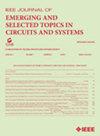Generative Refinement for Low Bitrate Image Coding Using Vector Quantized Residual
IF 3.7
2区 工程技术
Q2 ENGINEERING, ELECTRICAL & ELECTRONIC
IEEE Journal on Emerging and Selected Topics in Circuits and Systems
Pub Date : 2024-04-05
DOI:10.1109/JETCAS.2024.3385653
引用次数: 0
Abstract
Despite the significant progress in recent deep learning-based image compression, the reconstructed visual quality still suffers at low bitrates due to the lack of high-frequency information. Existing methods deploy the generative adversarial networks (GANs) as an additional loss to supervise the rate-distortion (R-D) optimization, capable of producing more high-frequency components for visually pleasing reconstruction but also introducing unexpected fake textures. This work, instead, proposes to generate high-frequency residuals to refine an image reconstruction compressed using existing image compression solutions. Such a residual signal is calculated between the decoded image and its uncompressed input and quantized to proper codeword vectors in a learnable codebook for decoder-side generative refinement. Extensive experiments demonstrate that our method can restore high-frequency information given images compressed by any codecs and outperform the state-of-the-art generative image compression algorithms or perceptual-oriented post-processing approaches. Moreover, the proposed method using vector quantized residual exhibits remarkable robustness and generalizes to both rules-based and learning-based compression models, which can be used as a plug-and-play module for perceptual optimization without re-training.使用矢量量化残差进行低比特率图像编码的生成式改进
尽管最近基于深度学习的图像压缩技术取得了重大进展,但由于缺乏高频信息,在低比特率下重建的视觉质量仍然受到影响。现有方法采用生成式对抗网络(GANs)作为额外损失来监督速率-失真(R-D)优化,能够生成更多高频成分以实现视觉愉悦的重建,但也会引入意想不到的虚假纹理。相反,这项工作建议生成高频残差,以完善使用现有图像压缩解决方案压缩的图像重建。这种残差信号是在解码图像和未压缩输入图像之间计算出来的,并量化为可学习编码本中的适当编码词向量,用于解码器侧的生成式细化。大量实验证明,我们的方法可以还原由任何编解码器压缩的图像的高频信息,并优于最先进的生成式图像压缩算法或以感知为导向的后处理方法。此外,所提出的使用矢量量化残差的方法具有显著的鲁棒性,并可推广到基于规则和基于学习的压缩模型,可用作感知优化的即插即用模块,无需重新训练。
本文章由计算机程序翻译,如有差异,请以英文原文为准。
求助全文
约1分钟内获得全文
求助全文
来源期刊

IEEE Journal on Emerging and Selected Topics in Circuits and Systems
ENGINEERING, ELECTRICAL & ELECTRONIC-
CiteScore
8.50
自引率
2.20%
发文量
86
期刊介绍:
The IEEE Journal on Emerging and Selected Topics in Circuits and Systems is published quarterly and solicits, with particular emphasis on emerging areas, special issues on topics that cover the entire scope of the IEEE Circuits and Systems (CAS) Society, namely the theory, analysis, design, tools, and implementation of circuits and systems, spanning their theoretical foundations, applications, and architectures for signal and information processing.
 求助内容:
求助内容: 应助结果提醒方式:
应助结果提醒方式:


